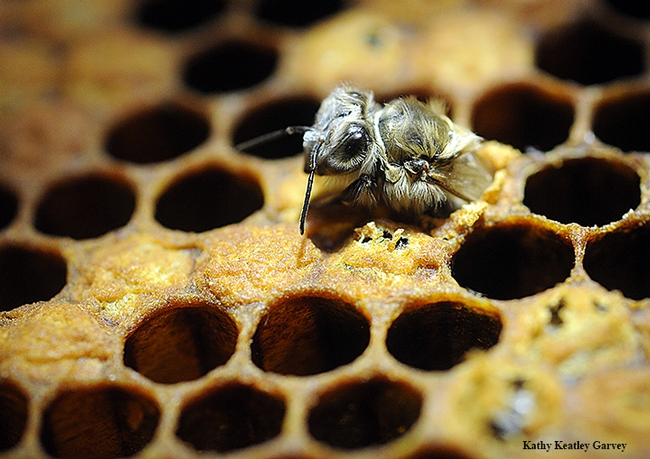- Author: Kathy Keatley Garvey

When you see honey bees foraging on the early blooming oxalis, that's a sure sign that February is approaching.
And that means it's time for some mead, music and a bee-influenced dinner.
The UC Davis Honey and Pollination Center is hosting its third annual fundraiser, The Feast: A Celebration of Mead and Honey, from 6 to 9 p.m., Saturday, Feb. 6 in the Robert Mondavi Institute of Wine and Food Science. Reservations are now underway. (See registration page.)
Mead, says Amina Harris, director of the Honey and Pollination Center, is "the world's oldest fermented beverage."
What's mead? "It's a fermented blend of honey, water and often fruits, yeast, or spices that dates back to about 7000 BCE," Harris says. Ceramic shards found in Jiahu, Henan Province, China held a mead-like residue, according to Patrick McGovern, the leading authority on ancient alcoholic beverages. According to the BBC the number of meaderies in the United States has increased from 30 to 40 to more than 250 in the last 10 years.
The event, to take place in the Mondavi Institute's Sensory Building on Old Davis Road, will begin at 6 with cocktails, live music, hors d'oeuvres and the featured ginger mead from Schramms Mead in Michigan. Select wines, honey lemonade and sparkling mead also will be served.
Ann Evans, author of the Davis Farmer's Cookbook, and Kathi Riley, caterer and former chef at Zuni Cafe, San Francisco, will serve a Mediterranean-style dinner.
Harris says the menu will include a triple avocado salad, followed by "a tagine of chicken, vegetables and couscous served family-style. A light cheese course will accompany a dessert mead flight with a wonderful citrus almond torte closing the festive evening."
Proceeds from the dinner will be used to support the outreach and education programs of the Honey and Pollination Center. Its mission is “to make UC Davis a leading authority on bee health, pollination and honey quality," Harris says.
Tickets for the dinner are $125 and are available online at http://honey.ucdavis.edu/. For more information contact Amina Harris at aharris@ucdavis.edu.
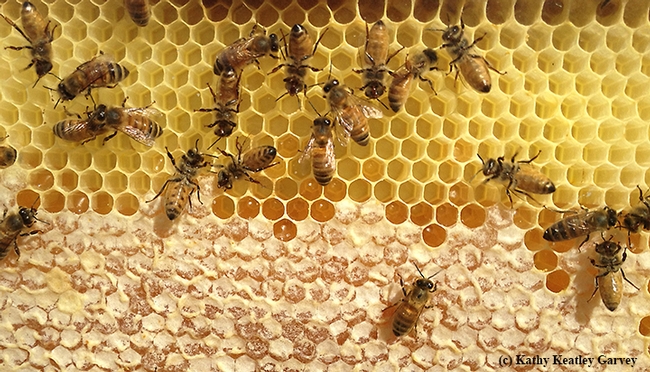
- Author: Kathy Keatley Garvey
It was a bee. One little bee.
What are the odds of a honey bee landing on the window of a UC Davis vehicle parked outside the California Bee Breeders' Association meeting on a cool January day--Wednesday, Jan. 20--at the Ord Bend Community Center, Glenn County?
Inside, it was a gathering of bee breeders talking about industry issues. Outside, it was a gathering of clouds, as the sun struggled to cast shadows where it could. The clouds would darken tomorrow, but it would not rain today.
There were no pollinators in sight.
Except for this one little bee, which landed on the windshield. Was it looking for those scarce floral resources? Or soaking in the warmth of the sun? Or waiting to be photographed?
Surely it will be involved in the almond pollination season which begins around Feb. 14.
"There are now 890,000 bearing acres of almonds!" bee breeder Jackie Park-Burris of Jackie Park-Burris Queens, Palo Cedro, and a past chairman of the California Sate Apiary Board, told us last week. "They're needing approximately 1,780,000 hives! That is probably close to 85 percent of the commercial hives in the U.S. It is definitely 100 percent of the quality commercial hives in the United States."
"Beekeepers are very thankful for the job," she added. "The pollen from the almonds is one of the healthiest pollens my bees get all year, they love it!The largest pollinating event in the world happens in California during the almond bloom. It is a $5.8 billion crop for growers and the economy of California."
And it all starts with the bees. One. Little. Bee.

- Author: Kathy Keatley Garvey

You're in luck.
The UC Davis Honey and Pollination Center is hosting an educational honey tasting on Wednesday night, Jan. 27 in the Sensory Theater of the Robert Mondavi Institute for Wine and Food Science on Old Davis Road. If you'd like to enroll, you need to register today (Monday, Jan. 20), To register, access this site.
The event, conducted by Amina Harris, director of the Honey and Pollination Center, will take place from 6:30 to 8:30 p.m. and will feature California honeys. Extension apiculturist Elina Niño of the UC Davis Department of Entomology and Nematology will talk about bees, honey and beekeeping.
Harris calls the event "a unique tasting experience, complemented with a short lecture delving into related beekeeping practices and issues." The cost is $30 (general), $25 (UC Davis affiliates), $12.50 (students).

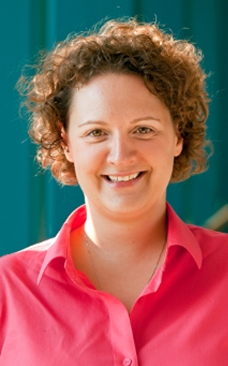
The Honey Flavor Wheel production involved six months of research and development. “We brought together a group of 20 people--trained tasters, beekeepers and food enthusiasts--who worked together with a sensory scientist to come up with almost 100 descriptors,” Harris recently said. “This wheel will prove invaluable to those who love honey and want to celebrate its nuances.”
"Honey is honey, it's just that simple," according to the National Honey Board. "A bottle of pure honey contains the natural sweet substance produced by honey bees from the nectar of plants or secretions of living parts of plants. Nothing else." The 60,000 or so bees in a hive may "collectively travel as much as 55,000 miles and visit more than two million flowers to gather enough nectar to make just a pound of honey!"
The United States is home to more than 300 unique kinds of honey, according to the National Honey Board. Among the most popular? Clover and orange blossom.

- Author: Kathy Keatley Garvey
He went from researching pest insects to targeting chronic pain in humankind.
He went from discovering a compound that alleviates pain (tested successfully on rodents, cats, dogs and horses) to forming a company EicOsis (pronounced eye-co-sis) to alleviate neuropathic and inflammatory pain in humans and companion animals.
Meet Bruce Hammock, the founder and CEO of EicOsis.
Hammock is a distinguished professor of entomology in the UC Davis Department of Entomology and Nematology who holds a joint appointment with the UC Davis Comprehensive Cancer Center.
He is on a mission, and clinical trials are on the horizon.
EicOsis has just received a $4 million federal grant to advance Hammock's compound discovery through Phase 1 clinical trials. The grant, “Development of an Oral Analgesic for Neuropathic Pain," is funded by the Blueprint for Neuroscience Research. National Institutes of Health (NIH).
The clinical trials, scheduled to begin in 2017, will target diabetic neuropathic pain, occurring in an estimated half of the world's 347 million diabetics, and 29 million Americans.
What exactly is the compound? It's "an inhibitor of the soluble epoxide hydrolase (sEH) enzyme,” said Hammock, whose fundamental research on the developmental biology of insects led to the discovery. “It is a key regulatory enzyme involved in the metabolism of fatty acids and treats pain by stabilizing natural analgesic and anti-inflammatory mediators.”
Many pain relievers are addictive, but not this one. Known as EC5026, the compound is “a potent, orally active and a non-narcotic analgesic that does not adversely affect the brain, gastrointestinal tract, or cardiovascular system,” said Alan Buckpitt, the company's vice president of pharmacology and emeritus professor of molecular biosciences at the UC Davis School of Veterinary Medicine.
“The EicOsis technology may solve a great need in pain treatment in providing a powerful analgesic which avoids the side effects of opioids (narcotics) and nonsteroidal anti-inflammatory drugs (NSAIDs),” said physician Scott Fishman, professor and chief of the Division of Pain Medicine, UC Davis Health System, who is not affiliated with the company. “The EicOsis compound holds great promise for controlling neuropathic pain in general and particularly for this difficult and common medical problem.”
A goal of the Blueprint Neurotherapeutics Network is to discover, develop and generate novel compounds that will ultimately be commercialized and benefit humankind.
When you think of all the havoc that diabetes wreaks (we all have family and friends suffering from the disease and its complications--and some 86 million Americans alone are pre-diabetic), it's good to see this exciting "bench-to-bedside" research.
"It's hard to know where science leads," Hammock acknowledged, noting that his research into how caterpillars turn into butterflies led to this treatment for pain.
Hammock is a fellow of the National Academy of Inventors, which honors academic invention and encourages translations of inventions to benefit society. He is a member of the U.S. National Academy of Sciences, a fellow of the Entomological Society of America, and the recipient of the Bernard B. Brodie Award in Drug Metabolism, sponsored by the America Society for Pharmacology and Experimental Therapeutics. He directs the campuswide Superfund Research Program, National Institutes of Health Biotechnology Training Program, and the National Institute of Environmental Health Sciences (NIEHS) Combined Analytical Laboratory.
A member of the UC Davis faculty since 1980, Hammock received his bachelor of science degree magna cum laude from Louisiana State University in entomology and chemistry, and his doctorate from UC Berkeley in entomology and toxicology, working in xenobiotic metabolism.
Meanwhile, we're all anticipating the clinical trials and what EC5026 can do.
(Note: see main news story on the UC Davis Department of Entomology and Nematology website and links to his work.)
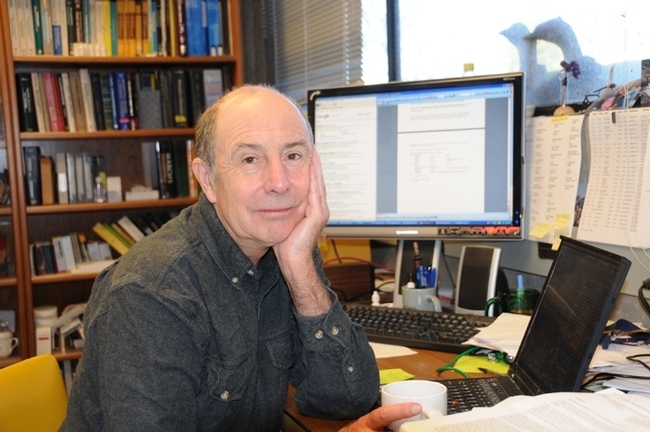
- Author: Kathy Keatley Garvey
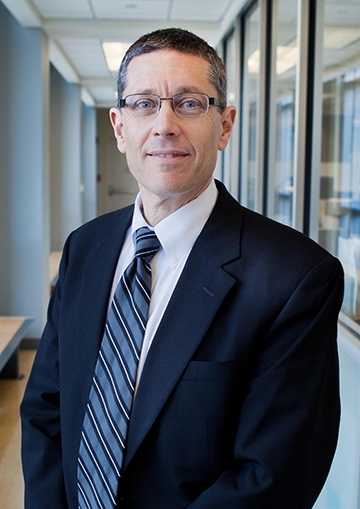
That's when eminent honey bee scientist Gene E. Robinson of the University of Illinois at Urbana-Champaign will speak on “Me to We: Using Honey Bees to Find the Genetic Roots of Social Life” in Jackson Hall, Mondavi Center for the Performing Arts, UC Davis campus.
His presentation, part of the Chancellor's Colloquium Distinguished Speakers Series, is from 4 to 6:30 p.m. Registration is underway on the Chancellor's Colloquium series website. The event is free and open to all interested persons but registration is required. (See Colloquium series website to register.)
Robinson pioneered the application of genomics to the study of social behavior and led the effort to sequence the honey bee genome.
Many of us have heard him speak, and many more have read his work. You may have heard him present a Tedx Talk, or read his piece on "The Behavior of Genes" (New York Times). Science writer Nick Zagorski profiled him in the Proceedings for the National Academy of Sciences (PNAS).
Robinson needs no introduction; his work is legendary. He is the University Swanlund chair and directs the Institute for Genomic Biology (IGB) and the Bee Research Facility. He received his doctorate in entomology from Cornell University in 1986 and joined the faculty of the University of Illinois at Urbana-Champaign in 1989.
He served as interim director of IGB, 2011-2012; director of the Neuroscience Program, 2001-2011; and leader of the Neural and Behavioral Plasticity Theme at the IGB, 2004-2011.
Robinson has authored or co-authored more than 275 publications, including 26 published in Science or Nature. He has been the recipient or co-recipient of more than $50 million in funding from the National Science Foundation, National Institutes of Health, U.S. Department of Agriculture and private foundations; pioneered the application of genomics to the study of social behavior; led the effort to gain approval from the National Institutes of Health for sequencing the honey bee genome; and founded the Honey Bee Genome Sequencing Consortium.
In addition, Robinson serves on the National Institute of Mental Health Advisory Council and has past and current appointments on scientific advisory boards for companies with significant interests in genomics.
His honors include University Scholar and member of the Center of Advanced Study at the University of Illinois; Burroughs Wellcome Innovation Award in Functional Genomics; Founders' Memorial Award from the Entomological Society of America; Fulbright Senior Research Fellowship; Guggenheim Fellowship; NIH Pioneer Award; Honorary Doctorate from Hebrew University; Fellow, Animal Behavior Society; Fellow, Entomological Society of America; Fellow, American Academy of Arts and Sciences; and member of the U.S. National Academy of Sciences.
A native of Buffalo, N.Y., Robinson received his doctorate in entomology from Cornell University, Ithaca, N.Y., in 1986. What prompted him to study entomology? You'll need to read Nick Zagorski profile of him in the Proceedings for the National Academy of Sciences (PNAS).
